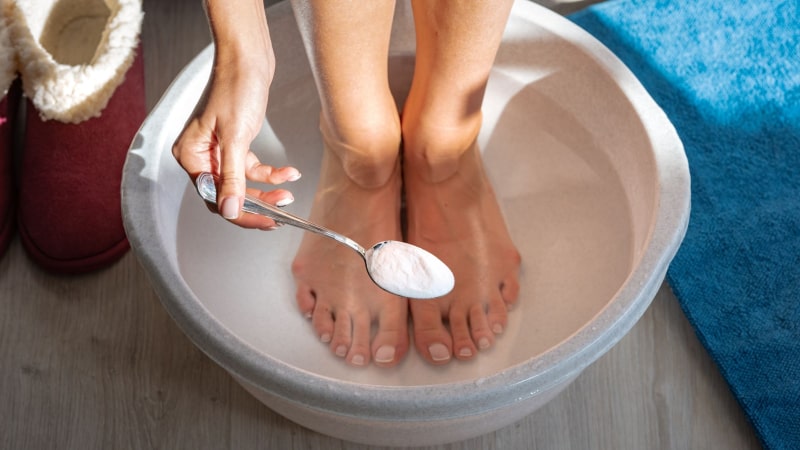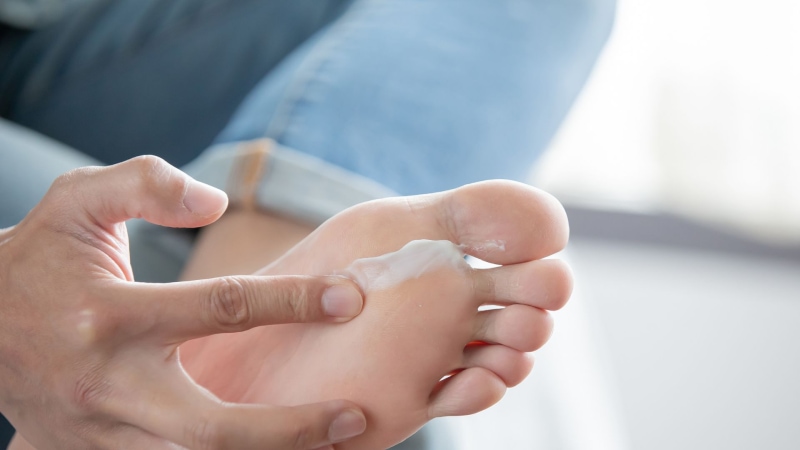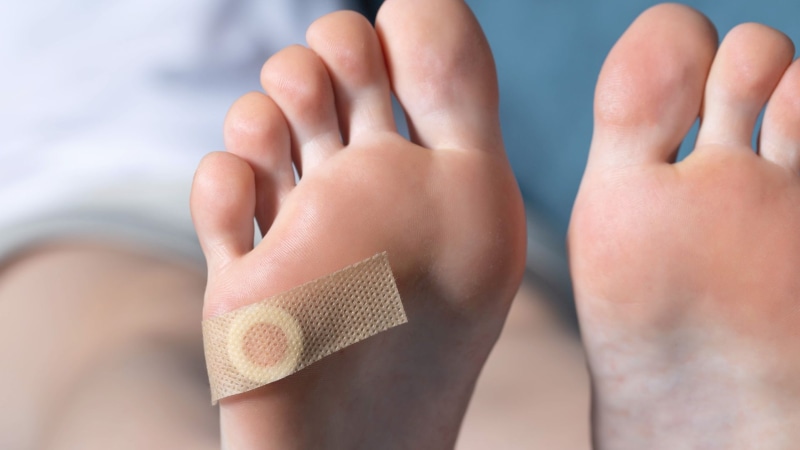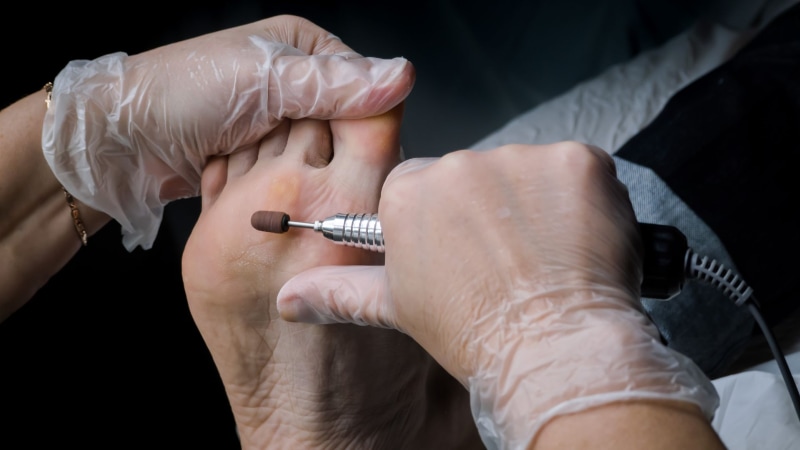The problem of corns on the feet affects many of us, but did you know that there is such a thing as a root corns? Find out more about this ailment and learn about effective methods of treating it.
Corns with root – characteristics
Cornswith root are specific thickenings of the epidermis, which are characterized by a hard base that can be felt when touched. Inside them is a so-called horny pivot, commonly known as a root. These are lesions that can cause great discomfort, especially when walking. These corns differ from calluses in that they are more limited and penetrate deep into the skin. They are mainly formed due to constant pressure or friction, often caused by inadequate footwear. Centrally located in the corns is the aforementioned horn pivot, which is cone-shaped. Its sharp tip is directed deep into the skin, which is the main cause of pain when walking. It is also worth noting that corns with a root can be confused with calluses, but the latter are more extensive and do not have a characteristic “root”. Corns with a root are more painful, especially when subjected to constant pressure.
Causes of corns with a root
Corns of this type most often occur as a result of wearing ill-fitting footwear that rubs or puts pressure on the skin. Prolonged exposure to such factors leads to the formation of corns on the foot with a root. However, footwear is not the only cause of their formation. Other factors include obesity, abnormal gait, prolonged standing and playing certain sports. Among the causes are also the wearing of mismatched socks, which can cause friction in certain areas of the foot. It is worth mentioning that corns can appear not only as a result of wearing shoes that are too tight, but also too loose, which do not provide adequate support for the foot and lead to an abnormal gait. All these factors lead to increased pressure on certain areas of the foot, which consequently leads to the formation of corns with a root.
Home remedies for corns with root
If the corns are not too big, we can try to get rid of them on our own. One popular home remedy is soaking the feet in soda. Another effective remedy is garlic, which has antibacterial properties and accelerates healing.
Step 1: Soak feet in baking soda
Soaking your feet in baking soda helps soften the skin and makes it easier to remove the corns. Simply prepare a bowl of warm water, add 2-3 tablespoons of baking soda and soak your feet for about 20-30 minutes. After this time, gently rub the affected area with a pumice stone.

Step 2: Application of garlic
Garlic is known for its antibacterial properties. To use it in the fight against corns, cut a clove of garlic in half and rub it over the area of the corns. You can also prepare a garlic patch – put a slice of garlic on the corns and secure with a bandage overnight.

Step 3: Moisturizing and exfoliating creams
Regular use of moisturizing creams can help prevent corns. However, if a corns has already appeared, it is worth using exfoliating creams available at pharmacies. They contain ingredients, such as urea, that help remove thickened skin.

Step 4: Patches for corns
Special patches for corns are available in pharmacies to help treat them. These patches contain exfoliating substances that speed up the healing process of corns. It is advisable to use them according to the manufacturer’s recommendations.
Although home methods can be effective in the fight against corns, for deep and painful corns with a root it is worth consulting a podiatrist.

Professional methods of removing corns
For large and painful corns, it is worth consulting a podiatrist. The specialist can use various methods of treatment, such as abrasion or sawing. There are also special treatment patches that help remove corns on the root of the foot. Here are some professional methods of removing corns:
- Laser corns removal: This is one of the newest and most effective methods. The procedure is minimally invasive, usually a one-time procedure, and produces quick results.
- Mechanical imprint removal: This uses tools such as a chisel, milling machine or scalpel. This is the most common method used by podiatrists.
- Electrocoagulation: The method involves the use of electric current to remove corns. It is performed under local anesthesia.
- Cryosurgery: The imprint is frozen in a controlled manner, leading to its destruction. This is a method often used by dermatologists.
- Healing patches: These are soaked in special substances that help softly remove corns. The patches should be stuck on the corns and replaced regularly.

Calluses, corns and corns – differences.
It is worth knowing that corns are thickened areas on the hands or feet that are more limited than calluses. Calluses are more extensive, while corns on the feet penetrate deep into the skin and have a root. Corns, on the other hand, are painful thickenings that differ from corns in structure and location.
Calluses are formed due to prolonged pressure or friction, most often on the feet, but can also appear on the hands. They are lesions that do not cause pain, but can be unsightly. Corns, otherwise known as corns, on the other hand, are painful thickenings of the skin that develop in areas subject to pressure, such as the joints of the fingers or areas between the toes. Corns can also be located under the nail plate, making them particularly painful.
Unlike calluses, which are flat, corns have a distinctive structure with a so-called root that penetrates deep into the skin and causes pain. Corns, although similar to corns, differ from them in location and are more convex.
It is important to distinguish between these three types of skin lesions, as treatment methods can vary depending on the type of lesion. If in doubt, it is worth consulting a podiatrist or dermatologist.
Summary of the problem of corns with a root
Corns with root are painful and unsightly lesions on the skin of the feet, which can cause a lot of discomfort. They are formed mainly due to wearing inappropriate footwear. There are many treatments, both home and professional. It is important to know how to distinguish corns from calluses and corns in order to treat them effectively.
Corns with root – frequently asked questions
To get rid of a corns with a root, it is best to consult a podiatrist who will use professional removal methods.
A root imprint will not disappear on its own and may require specialized treatment.
A root imprint is a hard skin lesion with a characteristic “root” penetrating into the deeper layers of the skin.
At home, you can try soaking the foot in warm water with Epsom salt and gently rubbing the corns with a pumice stone, but the effectiveness may be limited.
The cost of removing an imprint with a root depends on the clinic and region, but usually ranges from tens to hundreds of zlotys.
Removing an imprint with a root can be uncomfortable, but professional methods often minimize pain.

